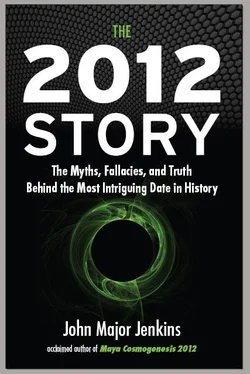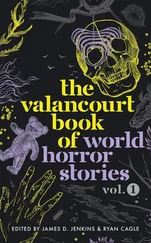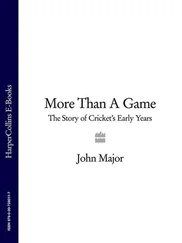My book Tzolkin primarily offered a reconstruction of the Venus calendar in the Dresden Codex, but also exposed the factual errors in the calendar system Argüelles had just presented in his new Dreamspell game/oracle. The seeds of that system had been planted, and were evident, in The Mayan Factor . The following offers a quick rundown on the factual problems.
The correlation used in the Dreamspell system is not aligned with the traditional, surviving day-count in the highlands of Guatemala, which has a direct unbroken lineage going back to the Classic Period Maya and beyond—to the very dawn of the 260-day calendar at least 2,500 years ago. On page 211 of The Mayan Factor , we find a list of tzolkin dates that tells us that, according to Argüelles, July 26, 1992, corresponds to 12 Ix. The count promoted by Argüelles was thus, at that time, 53 days out of synchronization with the day-count actually used today by the Maya. The discrepancy was repeated in the birthday calculator included in the Dreamspell game released in late 1991. In my early writings I referred to the surviving traditional day-count as “the True Count,” and I proposed that, in order to be clear, Argüelles’s day-count could charitably be referred to as a “Newly Created Count.” 19
The Dreamspell system skips counting leap day, February 29, which comes around every four years. This is the biggest no-no one could imagine, as it throws out of whack the internal consistency of the sacred 260-day rhythm. Every 260 days the same day-sign and number combination should come around and synchronize. By skipping a day, the “time resonance” factor of 260 days is compromised. For example, if you were born on June 15, 1966, your birthday according to the traditional tzolkin is 4 Muluc. Every 20 days Muluc recurs and every 260 days, 4 Muluc recurs, defining resonances with others whose birthdays fall on Muluc or another day-sign that has a resonant relationship with Muluc—for example, Cauac (opposite Muluc on the 20-day wheel of the day-signs). You might find that your grandfather was born on April 7, 1903, which was a 12 Muluc day. You would, according to the oracular use of the 260-day tzolkin calendar, have a special resonance with your grandfather. The traditional, surviving calendar utilizes these kinds of concepts and operations. Not so for Dreamspell. Because it skips counting February 29, there will be an accumulated error of 16 uncounted days between your grandfather’s birthday and your own. Looking up your birthdays in the Dreamspell calculator will not accurately reflect the real passage of days. It’s obvious that there is a problem here.
The reason why this feature was implemented in the Dreamspell system involves the fixing of the New Year’s Day to July 26. This date was indeed used by the Yucatec Maya as New Year’s Day. They did so because at the latitude of northern Yucatán the sun passes through the zenith at high noon on that day (as well as May 23). However, Argüelles states that July 26 was chosen in his system because it correlates with the ancient Egyptian heliacal rise of Sirius.
Nevertheless, the New Year’s Day wasn’t fixed for the Maya; it was intended to fall back one day every four years, probably in order to track a larger cycle known as the “year drift formula” (in which 1,507 tropical years = 1,508 haab of 365 days each). The modern Quiché Maya, for example, allow their New Year’s Day to cycle backward through the months of the year. Though somewhat counterintuitive to the modern mind, the ancient Maya didn’t need their mundane solar calendar to stay fixed to one New Year’s Day; instead, the sacred rhythm of 260 days had precedence.
It’s very possible that the Yucatec Maya intentionally tracked their New Year’s Day falling backward from July 26 to May 23, from one zenith passage to another, which took 256 years. This period corresponds to the all-important 13-Katun prophecy cycle, or May cycle, which scholar Prudence Rice has recently argued was an important key to Yucatec Maya cosmology and politics.
The point is that Argüelles’s policy of fixing New Year’s Day doesn’t reflect how the ancient Maya themselves actually used their calendars. The a priori assumption that this must be done led Argüelles to implement the highly dubious February 29 day skipping. But, again, no day-keeper would ever consider not counting a day. As a result, the day-count discrepancy of Dreamspell changes by one day every four years. While it was 53 days out of accord with the True Count between 1988 and 1993, it became 52 days out of whack between 1992 and 1996. And so on.
The so-called “day out of time,” July 25, is something entirely different. It was intended by Argüelles to keep the 364-day 13-moon calendar in sync with the New Year’s Day, July 26. The 13-moon calendar is, according to the Dreamspell view, supposed to be the “natural rhythm” that we should follow in order to synchronize ourselves with the natural earth-moon rhythm of life, reflected in women’s fertility cycles. A 28-day lunar cycle, however, is only an abstract average, useful only for an approximate reckoning of a numerologi cally handy 13 × 28 = 364 days. It quickly will shift out of step with real lunar cycles and thus doesn’t accurately track lunar rhythms. It can’t really do what its designer says it is supposed to do. 20
Another issue of dislocation, or misrepresentation, in Argüelles’s thought occurred in regard to the commencement of the last Katun of the Long Count. A Katun contains 7,200 days. The end date is December 21, 2012. Thus, the final Katun commences on April 5, 1993. In the early 1990s I circulated an article I wrote called “The Importance of April 5, 1993” and published it in my book Tzolkin . I noted the strange synchronicity that the final Katun commenced on a day on which Venus rose as morning star, and it was a full moon. This suggested a patterning between Venus and Katun cycles, which I plotted out, discovering that 3 Katuns equal 37 Venus cycles. In a 1991 interview with Antero Alli in the magazine Welcome to Planet Earth , Argüelles stated that the final Katun begins on July 26, 1992—the date then being promoted as the next Harmonic Convergence. Clearly, this was a very generalized mathematical operation, and it detracted from the very striking fact that the correct beginning date of the last Katun coordinated with a first appearance of Venus as morning star. Consequently, the morning star Venus rise that fell on the commencement of the final Katun of the 13-Baktun cycle was lost upon Dreamspell followers. However, an original thinker named Marko Bartholomew, who had acquired the original self-published version of my book Tzolkin in 1992, led a group of seekers up a volcano in Hawaii to observe Venus, Quetzalcoatl reborn, and the dawn of the final Katun.
I’m not meaning to be difficult, but all of these errors are of a fundamental nature and to any discerning mind would render the Dreamspell system problematic, at best. It’s not a matter of debatable opinions; my critique is addressed to the level of stated facts and functional operation. After I published my critique of Dreamspell-think in my book Tzolkin , I immediately came under fire by members of the Dreamspell group, who frequently accused me of impugning the wisdom of their teacher. For example, Steven Starsparks sent me a postcard filled with four-letter words after reading my book, aghast at my audacious questioning of the wisdom of the Dreamspell revelation. For four years I exchanged more than three hundred letters with various disillusioned Dreamspellers (this was before e-mail) in which I patiently tried to educate them about the existence of an authentic surviving day-count—and that the Argüellian system simply was not it. “Disillusioned” is an apt word for what they were going through. I hoped that Argüelles himself might offer some clarification, which was not forthcoming for many years. My 1993 book 7 Wind: A Quiché Calendar for 1993 was intended as a simple introductory guidebook to how the Maya day-keepers use their tzolkin calendar.
Читать дальше












